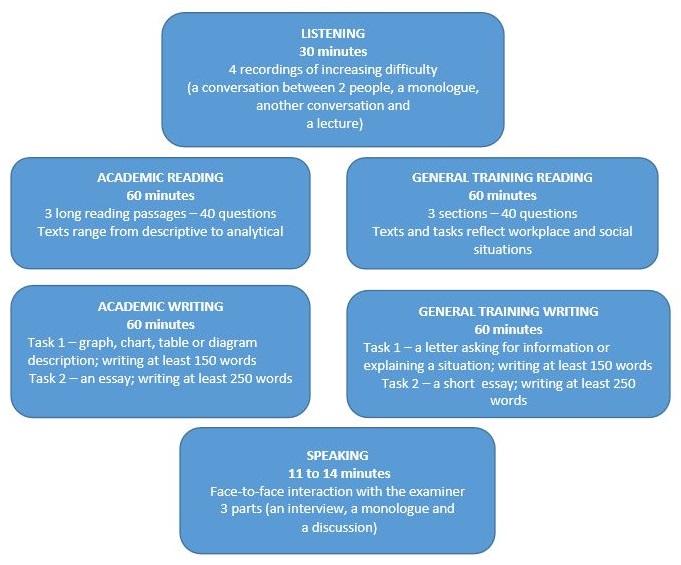
The International English Language Testing System, or IELTS, is a standardized test of English language proficiency for non-native English language speakers.
IELTS Exam Format
The IELTS Academic module tests the language skills of non-native English language speakers who want to study at a college or university in an English-speaking country where the medium of instruction is English. IELTS is recognized by most academic institutions and professional organizations in Europe, Australia, Canada, New Zealand and the United States.
The IELTS General Training module tests the language ability of non-native English language speakers who intend to go abroad, especially to English-speaking countries for vocational training programmes (not for degree), work or immigration. Employers, professional bodies and immigration departments in Australia, Canada, New Zealand, the UK, the USA and more than 140 other countriesrecognize IELTS exam as proof of English language pro?ciency level.
Read: IELTS Academic vs IELTS General?
Both the modules consist of four parts: Listening, Reading, Writing and Speaking. Listening and Speaking are the same for both modules.
Score / Grade Range
You can receive a score from 1 to 9 in each part of the test (Listening, Reading, Writing and Speaking). Your overall band score is equal to the average of the scores of the four parts. You can receive a whole (e.g. 6.0, 7.0, 8.0) or a half (e.g., 6.5, 7.5, 8.5) bands in each part of the test.
Related Reads
Tips to Achieve a High Score in IELTS
Listening
Before the IELTS Listening test:
- Listen to radio programmes, news, and lectures; watch films and online videos in English. Try to familiarize yourself with British English. You can take the help of British news channels such as BBC for this purpose.
- Familiarize yourself with each listening test question type such as multiple choice, matching and labelling.
During the IELTS Listening test:
- Listen to the audio instructions before each section carefully. These instructions are not printed in the test booklet.
- Read the instructions in the test booklet carefully for the number of words you need to write on the answer sheet. If you write more words than required, you will lose marks.
- Read the questions before listening. 30 to 60 seconds are given for reading the questions and instructions.
- Underline the key words in the question. However, listen to the synonyms and paraphrases too.
- Visualize the situation and try to predict the answer.
- Pay special attention to negatives (not, never, none, no one, barely, hardly, scarcely, etc.)
- Check your answers during the 30-second pause time after each section.
- During the 10-minute time, transfer the answers from the test booklet onto the answer sheet.
- Make sure you have transferred all answers onto the answer sheet. Do not leave empty spaces even if you don’t know the answer; make your best guess
- Make sure you have used correct grammatical form and correct spelling of the word(s) in your answer.
Reading
Before the IELTS Reading test:
- Read newspapers, magazines, journals, and books in English. While reading, underline or highlight less common words.
- Practice guessing the meaning of an unknown word from the context. If you still do not understand the meaning of the word, check it in a dictionary.
- Keep up with the news. The topics of the reading passages often deal with current affairs.
- Be familiar with each Academic or General Training reading test question type.
- Practise reading within a time frame. You need to be able to read fast in order to be able to read all three passages and answer 40 questions in 60 minutes.
- Practise reading techniques such as skimming, scanning and intensive reading.
During the IELTS Reading test:
- Read the instructions carefully during the test as they may slightly differ from the ones you got familiar with while practicing the test.
- Underline key information and/or make notes in the reading passages in the test booklet.
- Divide your time wisely: if you spend more than a minute answering a question and still do not have an answer, leave it and proceed to the next question. If you have some time left after you answer the rest of the questions, you may return to the question.
- Make sure you have transferred all answers onto the answer sheet. Do not leave empty spaces even if you don’t know the answer; take your best guess.

